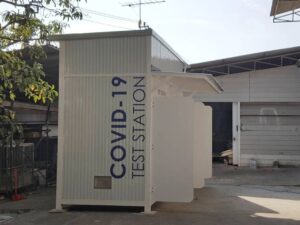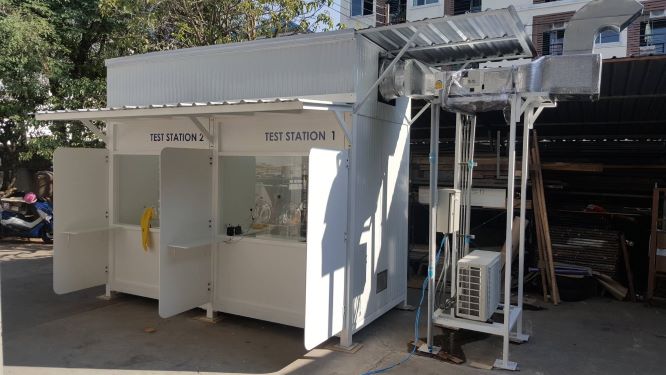สืบเนื่องจากสถานการณ์การระบาดของโรคติดเชื้อโควิด-19 ยังคงมีการแพร่ระบาดอย่างต่อเนื่อง ส่งผลให้มีบุคลากรทางการแพทย์จำนวนหนึ่งได้รับเชื้อจากผู้ป่วยระหว่างทำการตรวจและรักษา เนื่องจากอุปกรณ์ป้องกันตัวเองอย่างเช่น หน้ากากอนามัยแบบ N95 มีความขาดแคลน ดังนั้นเพื่อลดความเสี่ยงการติดเชื้อให้กับบุคลากรทางการแพทย์และผู้ที่มาเข้ารับการรักษาที่โรงพยาบาลด้วยโรคอื่น ๆ จึงเป็นจุดเริ่มต้นของงานดีไซน์แบบสถานีคัดกรองผู้ป่วยโควิด-19 หรือ COVID-19 Test Station ที่เกิดจากการออกแบบของอาจารย์สุนารี ลาวัลยะวัฒน์ และ Dr. Martin Schoch อาจารย์คณะสถาปัตยกรรมศาสตร์และการออกแบบ มหาวิทยาลัยเทคโนโลยีพระจอมเกล้าธนบุรี (มจธ.)

อาจารย์สุนารี ลาวัลยะวัฒน์ อาจารย์คณะสถาปัตยกรรมศาสตร์และการออกแบบ มจธ. กล่าวว่า เริ่มแรกทางทีมได้ออกแบบตู้ชุดแรกเพื่อใช้สำหรับการตรวจแบบ Nasal Swab Test ซึ่งเป็นการตรวจสารคัดหลั่งหลังโพรงจมูก และในบริเวณคอของผู้ป่วย ด้วยเทคนิค Polymerase Chain Reaction (PCR) พบว่าบุคลากรทางการแพทย์ต้องเข้าใกล้ตัวผู้ป่วยมาก รวมถึงได้ทราบจากแพทย์และผู้เชี่ยวชาญด้านต่าง ๆ ว่าทุกขั้นตอนการตรวจคัดกรอง ตั้งแต่ก่อนตรวจ ระหว่างตรวจ และหลังการเข้ารับการตรวจนั้นล้วนมีความเสี่ยงทั้งสิ้น เนื่องจากแต่ละโรงพยาบาลมีผู้มารอตรวจจำนวนมากทำให้เกิดความแออัด จึงคิดต่อเนื่องเป็นงานออกแบบของสถานีคัดกรองผู้ป่วยโควิด-19 โดยจะแบ่งเป็น 5 จุด 5 สถานีย่อย ดังนี้ จุดที่ 1 คือ ทำการประเมินว่าเป็นคนไข้ที่เข้าเกณฑ์การตรวจหรือไม่ จุดที่ 2 คือ จุดให้คำปรึกษาหลังจากที่ผ่านการประเมินเข้าเกณฑ์แล้ว จุดที่ 3 Swab Test การตรวจสารคัดหลั่งหลังโพรงจมูกและในบริเวณคอ จุดที่ 4 จุดจ่ายยาสำหรับบรรเทาอาการเบื้องต้น ระหว่างรอผลตรวจ เช่น ยาแก้ปวด ลดไข้ จุดที่ 5 จุดลงทะเบียนติดตามผล

อาจารย์สุนารี ลาวัลยะวัฒน์ ยังเปิดเผยเพิ่มเติมด้วยว่าปัจจุบันทางทีมได้ส่งมอบแบบไปยังโรงพยาบาลแล้ว ทั้งหมด 5 แห่ง ได้แก่ รพ.สมิติเวช สุขุมวิท รพ.เทศบาลนครอุดรธานี กองวิศวกรรมการแพทย์ กระทรวงสาธารณสุข เทศบาลนครนครสวรรค์ รพ.ค่ายสมเด็จพระนเรศวรมหาราช เทศบาลนครพิษณุโลก และกลุ่มงานโครงสร้างพื้นฐานและวิศวกรรมทางการแพทย์ รพ.ศรีสะเกษ และยินดีที่จะส่งมอบแบบให้กับโรงพยาบาลต่าง ๆ ที่ต้องการนำไปใช้ประโยชน์ โดยโรงพยาบาลสามารถนำไปปรับให้เข้ากับพื้นที่และงบประมาณของแต่ละโรงพยาบาลไปดำเนินการก่อสร้างได้เอง โดยจะมีทีมงานอาจารย์คอยให้คำปรึกษาในการนำแบบไปปรับใช้ให้เหมาะสมกับพื้นที่และมีประโยชน์สูงสุดต่อไป อีกทั้งยังได้ทำความร่วมมือกับบริษัท ทีโอที จำกัด (มหาชน) และสถาบันวิทยาการหุ่นยนต์ภาคสนาม มจธ. นำตู้โทรศัพท์เก่ามาประยุกต์ใช้ โดยยึดหลักการที่ว่าทำอย่างไรที่จะใช้งานเป็นสถานีคัดกรองแบบประยุกต์นอกอาคาร เพื่อเข้าไปช่วยเหลือในพื้นที่โรงพยาบาลชุมชน หน่วยงานสาธารณสุขที่ห่างไกล และต้องการสนับสนุนในช่วงวิกฤต โรงพยาบาลหรือสถานพยาบาลที่ต้องการสอบถามข้อมูล ติดต่อได้ที่อีเมล sunaree.law@mail.kmutt.ac.th หรือ https://bit.ly/TOT-COVID-19-Test-Station

KMUTT architecture lecturers offer hospitals the COVID-19 patient screening sub-station design with specific zones to reduce risk of transmission
As the COVID-19 outbreak continues, healthcare workers become infected during testing and treatment for potentially infected people. While personal protective equipment such as the n95 mask is rare, the design for the COVID-19 test station by Ms. Sunaree Lawanyawatna and Dr. Martin Schoch, architecture lecturers from SoA+D: School of Architecture and Design from KMUTT, has been developed. It is said to help reduce the spread of the disease to medical staff and other hospital patients.
Ms. Sunaree Lawanyawatna, SoA+D: School of Architecture and Design, King Mongkut’s University of Technology Thonburi (KMUTT) disclosed that earlier, the team designed a single booth for conducting a nasal swab. The swab is a method for collecting a test sample of nasal secretions from the back of the nose and the throat by using a polymerase chain reaction or PCR technique. Health care workers must be in very close contact with patients. She learned from interviews with doctors and experts that throughout the process of providing care, during and after the treatment, health care workers face the risks of infection. At each hospital, many patients are waiting, hence crowd gatherings occur. Out of this necessity, her continued ideas of five connected stations of COVID screening areas have emerged. The first station is to assess whether the patient meets the criteria for testing or not. The second is where health workers provide consultation after the assessment. Next is where the nasal swab-test takes place. The fourth is the medication dispensing substation for general symptoms while waiting for results such as painkillers and fever reducer. The last, the fifth substation is the registration point for follow-up.

Ms. Sunaree Lawanyawatna also added that drawing documentations of the design were provided to six hospitals, which are: Samitivej Sukhumvit Hospital, Udon Thani Municipality Hospital, Medical Engineering Division, Ministry of Health, Nakhon Sawan Municipality, Fort Somdej Phranaresuan Maharaj Hospital, Pitsanulok Municipality, Infrastructure and Medical Engineering Subdivision of Sri Saket Hospital, and Khanom Hospital, Nakhon Si Thammarat. The team continues to offer the design to more hospitals, which can be modified to suit the area, required use or budget of each hospital.
Together with the Institute of Field Robotics (FIBO) and TOT Public Company Limited, the team is cooperating on the adaptation of old phone booths for the screening and sample-taking purposes to assist the work of community hospitals and public health agencies in remote areas. Interested parties requiring more information can email sunaree.law@mail.kmutt.ac.th or visit https://bit.ly/TOT-COVID-19-Test-Station

